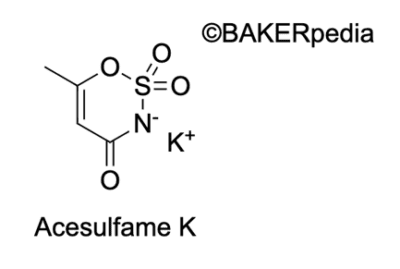Acesulfame
What is Acesulfame?
Acesulfame is an artificial sweetener used to substitute sugar in low calorie products. It is 100 – 300 times sweeter than sucrose. Acesulfame is most commonly used in foods and soft drinks in combination with aspartame to provide a sweet flavor without metallic aftertaste.1
- Acesulfame is mainly available as a potassium salt. Calcium and sodium acesulfame can be produced but are not as sweet.1
- Commercially available acesulfame K is found as a white crystalline powder, stable at room temperature.1
Chemical Formula

Origin
Acesulfame K was first discovered in 1967 by Claus and Jensen but the process involved using raw materials that were difficult to handle. Today’s process is based on the reaction of sulfamic acid and diketene. 1
In 1978, the WHO declared the registered name of acesulfame potassium salt as the generic term for this compound.1 Today, it is one of the most commonly used alternative sweeteners in the food industry.1
Function
This sweetener is used mainly as a sweetener in low calorie baked goods. It provides a similar taste profile to sucrose although at lower concentrations. It provides a clean taste and little to no residual metallic off-flavors.1,2
Commonly used in blends of alternative intense sweeteners for better results, the proportions of sweeteners will depend on the application.2
Nutrition
It is a non caloric sweetener because it cannot be metabolized by humans.The Acceptable Daily Intake (ADI) of acesulfame K is 0 -15 mg/kg.2 It is considered a non cariogenic sweetener, and it has shown no impact on glycaemic control.1
Commercial production
Acesulfame K is commercially produced using the following process:2
- Reaction of acetoacetamide-N-sulfonic acid with sulfur oxide to produce dihydrooxathiazinone dioxide ring system.
- Salt reaction: KOH is added to the solution to produce acesulfame K salt.
- Isolation: the solution is centrifuged to isolate this.
- Washing: water is added to wash the product, and remove potential impurities.
- Drying: this sweetener is dried using a vacuum drier to obtain a crystalline powder.
- Sieving: to the appropriate granulometry.
- Packaging
Application
Acesulfame is commonly used in low calorie food products such as:1
- Carbonated beverages
- Dairy products and edibles ices
- Baked goods
- Cereals
- Sweets and chewing gums
- Jams, marmalades and preserves
- Delicatessen products
- Edible papers
When using this in baking, several considerations should be taken into account: 1,2
- Water-soluble bulking agent should be used to adjust texture, due to the absence of the bulking properties of sugar when using acesulfame.
- Sugar-alcohols should be used as potential bulking agents for texture adjustment.
- Common usage levels are around or below 1000 mg/kg.
- Does not significantly affect the product’s texture or appearance.
- It works synergistically with sugar alcohols.
- Yields paler products due to lack of reducing sugars for Maillard browning reactions.
- Stable under baking pH and temperature conditions.
- Most common blend of acesulfame K is with aspartame in sweet beverages.
Regulations
According to the FDA, Acesulfame K can be safely added to food products except meat and poultry as an all-purpose sweetener and flavor enhancer.3
In the EU, this (E 950) was allowed for “fine bakery products for particular nutritional uses (diabetic food products)”. Since 2018, this category of “diabteic food products” has been eliminated, and thus fine bakery products are regulated by the Nutritional Health Claims Regulations 1924/2006 that doesn’t include the use of saccharin in bakery products.4
References
- O’Brien-Nabors, L. Alternative Sweeteners. United States: CRC Press, 2016.
- Mitchell, H. Sweeteners and sugar alternatives in food technology. John Wiley & Sons, 2008.
- Food and Drug Administration (FDA). US Department of Health and Human Services. CFR Code of Federal Regulations Title 21, Part 172 Food Additives Permitted For Direct Addition To Food For Human Consumption, https://www.accessdata.fda.gov/scripts/cdrh/cfdocs/cfcfr/cfrsearch.cfm?fr=172.800 , Accessed 18 July 2021.
- “EU Bans Use Of Artificial Sweeteners In Dietetic Bakery Products”. Apps.Fas.Usda.Gov, 2018, https://apps.fas.usda.gov/newgainapi/api/report/downloadreportbyfilename?filename=EU%20Bans%20Use%20of%20Artificial%20Sweeteners%20in%20Dietetic%20Bakery%20Products_Brussels%20USEU_EU-28_2-5-2018.pdf . Bans Use of Artificial Sweeteners in Dietetic Bakery Products_Brussels USEU_EU-28_2-5-2018.pdf. Accessed 10 July 2021.


